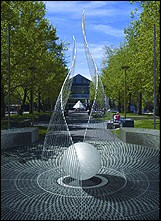John Garran – a Survivor of the Burma-Thailand Railway
contributed by Michael Hall
|
John Garran was the second son of Sir Robert Garran, one of the architects of the Australian Constitution. He spent one year at university then left to pursue a farming career. After jackarooing for a time he took up the lease at Bonshaw, between Fyshwick and Queanbeyan, in 1928. He specialised in wool growing and was awarded a master farmer certificate for his skills. John Garran was a large man, about 6 feet 5 inches tall, and suffered as much as any of the POWs. There was widespread testimony to his spiritual strength and his practical efforts to survive and to help others to survive. “You mustn't die”, he used to say, “It would be one up to them”. A Canberra boy who did come home tried to express what John had done for him; he simply said, “He listened”. One prisoner said, “He used to look down at the Japanese scurrying around like ants when something was wrong, and roar with laughter. It really made them mad.” According to another he would use his farming knowledge to experiment with eating insects, leaves and roots from the jungle. If a food source didn't upset him then it would be alright as a supplement to the diet of other prisoners. He would mix it in with rice flour and cook a kind of damper. Garran would also unravel any material he could find so he could make yarn. He taught himself to knit so that he could turn the yarn into covers for men with injured or amputated limbs. A devoted historian, he contributed several papers on the history of livestock in Australia and was writing an account of the history and genetic development of the merino sheep when he died. The manuscript was completed by a colleague and published as 'Merinos, Myths and Macarthurs' in 1985. |
 |

